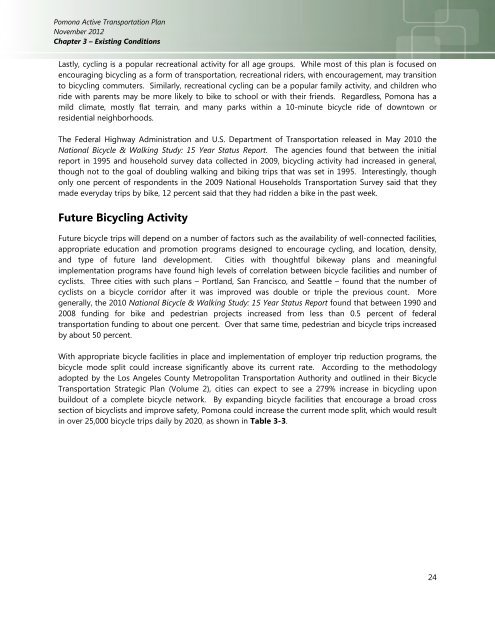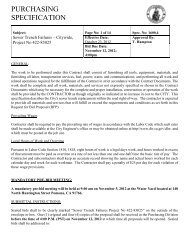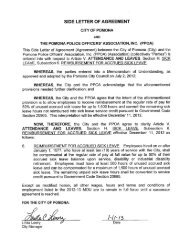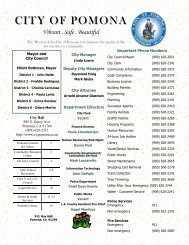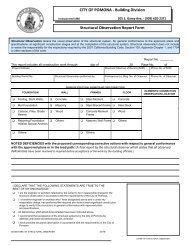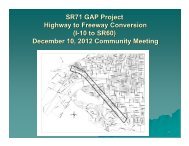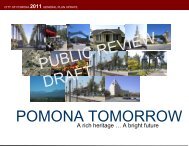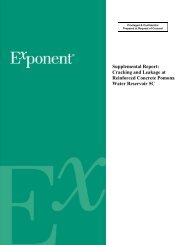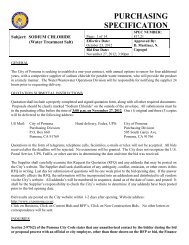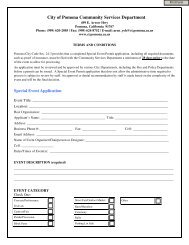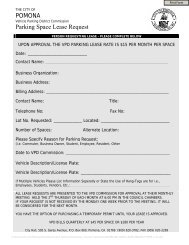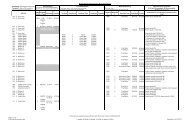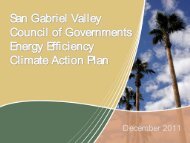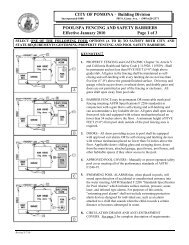Active Transportation Plan - City of Pomona
Active Transportation Plan - City of Pomona
Active Transportation Plan - City of Pomona
Create successful ePaper yourself
Turn your PDF publications into a flip-book with our unique Google optimized e-Paper software.
<strong>Pomona</strong> <strong>Active</strong> <strong>Transportation</strong> <strong>Plan</strong><br />
November 2012<br />
Chapter 3 – Existing Conditions<br />
Lastly, cycling is a popular recreational activity for all age groups. While most <strong>of</strong> this plan is focused on<br />
encouraging bicycling as a form <strong>of</strong> transportation, recreational riders, with encouragement, may transition<br />
to bicycling commuters. Similarly, recreational cycling can be a popular family activity, and children who<br />
ride with parents may be more likely to bike to school or with their friends. Regardless, <strong>Pomona</strong> has a<br />
mild climate, mostly flat terrain, and many parks within a 10-minute bicycle ride <strong>of</strong> downtown or<br />
residential neighborhoods.<br />
The Federal Highway Administration and U.S. Department <strong>of</strong> <strong>Transportation</strong> released in May 2010 the<br />
National Bicycle & Walking Study: 15 Year Status Report. The agencies found that between the initial<br />
report in 1995 and household survey data collected in 2009, bicycling activity had increased in general,<br />
though not to the goal <strong>of</strong> doubling walking and biking trips that was set in 1995. Interestingly, though<br />
only one percent <strong>of</strong> respondents in the 2009 National Households <strong>Transportation</strong> Survey said that they<br />
made everyday trips by bike, 12 percent said that they had ridden a bike in the past week.<br />
Future Bicycling Activity<br />
Future bicycle trips will depend on a number <strong>of</strong> factors such as the availability <strong>of</strong> well-connected facilities,<br />
appropriate education and promotion programs designed to encourage cycling, and location, density,<br />
and type <strong>of</strong> future land development. Cities with thoughtful bikeway plans and meaningful<br />
implementation programs have found high levels <strong>of</strong> correlation between bicycle facilities and number <strong>of</strong><br />
cyclists. Three cities with such plans – Portland, San Francisco, and Seattle – found that the number <strong>of</strong><br />
cyclists on a bicycle corridor after it was improved was double or triple the previous count. More<br />
generally, the 2010 National Bicycle & Walking Study: 15 Year Status Report found that between 1990 and<br />
2008 funding for bike and pedestrian projects increased from less than 0.5 percent <strong>of</strong> federal<br />
transportation funding to about one percent. Over that same time, pedestrian and bicycle trips increased<br />
by about 50 percent.<br />
With appropriate bicycle facilities in place and implementation <strong>of</strong> employer trip reduction programs, the<br />
bicycle mode split could increase significantly above its current rate. According to the methodology<br />
adopted by the Los Angeles County Metropolitan <strong>Transportation</strong> Authority and outlined in their Bicycle<br />
<strong>Transportation</strong> Strategic <strong>Plan</strong> (Volume 2), cities can expect to see a 279% increase in bicycling upon<br />
buildout <strong>of</strong> a complete bicycle network. By expanding bicycle facilities that encourage a broad cross<br />
section <strong>of</strong> bicyclists and improve safety, <strong>Pomona</strong> could increase the current mode split, which would result<br />
in over 25,000 bicycle trips daily by 2020, as shown in Table 3-3.<br />
24


